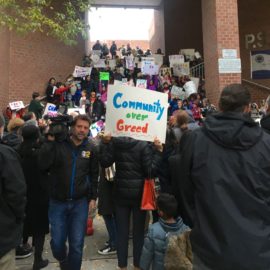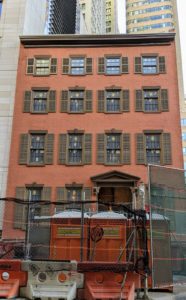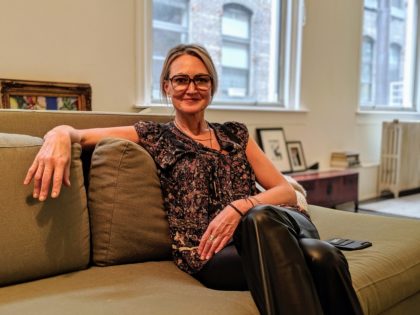Citizen of the Month: Tricia Joyce
Tricia Joyce is such a shoe-in for Citizen of the Month that I don’t even think the Department of Education, which was most often the target of her activism, would disagree. In fact, while she has needled them and pushed them and dragged them along, in some cases, for the past 13 years, I think even they would agree that she is as much as cheerleader for the city’s public schools as she is a critic. And there’s no doubt that she’s in it for the kids — and not just her own.
I’m going to start with a quick summary of the schools that opened in the decade that Tricia helped* steer several different task forces focused on overcrowding, and then revert back to the fun Tribeca stuff, just to give you a road map. (The quotes are Tricia’s.) In my mind, this is her legacy to the neighborhood:
- Millennium High School: Opened in 2002 with funds from CB1, Bill and Melinda Gates and others. “We got the 14th floor expansion approved in 2019 and it will (hopefully) be finished and open by fall 2022.”
- Spruce Street School (PS 397): Incubated in Tweed in 2009-2010 and opened in the Gehry tower in 2011.
- PS/IS 276 (Battery Park City School): Incubated at Tweed 2009 (together with Spruce) and opened in 2010.
- Peck Slip School (PS 343): “It was Paul Hovitz’s idea that it should be pitched as a school and so we went after it when the post office closed in 2012.” Approved in 2012, incubated at Tweed in 2013 and opened in 2015.
- 75 Morton (MS 297): Opened in 2017. “We desperately needed another zoned middle school. CB2 did most of the heavy lifting to get it approved but we got downtown west of Church zoned for it. It was a hike, especially for those in BPC, to get to Baruch.”
- Trinity Place / 77 Greenwich: Approved 2016; will open (“with luck, since they stopped construction for four months in covid”) in fall 2022. PS 150 will move into it when it opens.
Tricia moved to Tribeca in 1990 in her 20s, after a brief gig modeling in runway shows for Christian Dior (“It was never a career.”) She landed first in a brownstone on the Upper Westside, but then a year later headed south.
“If you were moving downtown, you looked in The Village Voice.” It’s there that she saw an ad: mini loft, Warren Street, $900. “I had never been down here before, and it felt like I lived in a small town. I would put my raincoat over my pajamas on a Sunday morning and walk to Bubby’s and not see a soul.”
She had planned to find a job as an art director but while helping a photographer as a favor, he asked her to rep him. The first office for Tricia Joyce Inc. was one phone line on a mattress in her apartment; she incorporated in 1997 when she took a commercial space at 79 Chambers with Ken Smith, the landscape architect.
“It seems like a different lifetime altogether,” Tricia says of those early Tribeca days. “People like to be nostalgic, but there were also hard parts. There were no amenities. It wasn’t chic at all. Kitchenette [which opened in 1994 and closed in 2015] saved us — it did a lot for our spirit. And then Triburbia was born.”
After 9/11, when her office was “below the fence,” she ran the company from the Tribeca Grand, which gave her three phone lines and a fax machine for $90 a month. Her entire infrastructure — which was based on five hunting lines and messengers — was gone. She never did return to her office on Chambers, but she lives now on Duane and her office is in Soho.
“This neighborhood, this is my home,” she says. “I came of age here. I made all my friends here. I will always be connected here.”
Her girls, twins Helen and Claire, with husband Todd Burris, were born in 2003, and the young family lived for a time at IPN, where they could fall into Washington Market Park and where, she said, they grew to rely on neighbors. “That’s when I really understood community. It was a godsend that so many people had eyes on my kids.”
 But by then, the schools were facing their latest challenge: overcrowding. Tricia had joined CB1 as a public member in 2008, and that spring, she introduced herself to Eric Greenleaf — a 234 parent and a professor at NYU’s Stern School of Business — at a presentation by then-Borough President Scott Stringer’s office on the issue. He asked her to join a task force started by longtime Assemblyman Shelly Silver. Eric had also just formed an overcrowding committee at PS 234, and she joined that too when the girls started school that fall. The annex had just opened, but principal Lisa Ripperger’s time was spread thin by the demands.
But by then, the schools were facing their latest challenge: overcrowding. Tricia had joined CB1 as a public member in 2008, and that spring, she introduced herself to Eric Greenleaf — a 234 parent and a professor at NYU’s Stern School of Business — at a presentation by then-Borough President Scott Stringer’s office on the issue. He asked her to join a task force started by longtime Assemblyman Shelly Silver. Eric had also just formed an overcrowding committee at PS 234, and she joined that too when the girls started school that fall. The annex had just opened, but principal Lisa Ripperger’s time was spread thin by the demands.
“Things were so crazy at 234 in the fall of 2008 that I put portable sinks for the annex on my credit card as they hadn’t yet plumbed the art room,” Tricia said.
By then Eric had crunched the numbers that, it seemed, the DOE was intent on denying. 33,000 new apartments built in a decade. 71,000 new residents. 250 percent population growth in Fidi. The largest growing community in the United States.
And virtually no plans for added infrastructure like schools.
Eric was able to run public data in his free time that showed just how many school seats the neighborhood would need — something the DOE couldn’t or didn’t want to do. The two of them walked the neighborhood to identify sites for the city.
“My mother always said, if you’re going to complain, then get involved,” Tricia says. “It was an easy decision.”
You can see the results above. *And I will add — because I know Tricia would want me to, since she was a reluctant Citizen of the Month — that clearly this was not a solo effort.
 Fast forward to 2020, where the school system — and its kids — faced unprecedented challenges. The fight to keep PS 150 in its own space for a few more years was successful, but now its new home at 77 Greenwich was being delayed (more on that soon, though that’s the historic mansion attached to it, left). Not only were schools facing massive changes with the pandemic, the process for the specialized schools was thrown into the mix. Kids were facing huge academic hurdles, mental health issues, the anxiety of being cut off from sports, from clubs, from volunteer efforts, from each other.
Fast forward to 2020, where the school system — and its kids — faced unprecedented challenges. The fight to keep PS 150 in its own space for a few more years was successful, but now its new home at 77 Greenwich was being delayed (more on that soon, though that’s the historic mansion attached to it, left). Not only were schools facing massive changes with the pandemic, the process for the specialized schools was thrown into the mix. Kids were facing huge academic hurdles, mental health issues, the anxiety of being cut off from sports, from clubs, from volunteer efforts, from each other.
“Kids are not supposed to be isolated from the world, especially teenagers,” says Tricia. “There are some kids who are doing incredibly well right now, but most are not — especially kids with special needs. I am worried for our kids and their mental health. It’s heavy heart stuff.”
For now, she’s relieved to see that the space for 150 is back on track to accommodate 478 students. As chair of CB1’s Education Committee, there are still issues she wants to tackle: mental health, special ed, class size. And another downtown high school.
“I feel like the really big planning issues have been resolved, but there is so much more to do,” she says. “Now that we’ve gotten to survival, I am really excited to turn my attention to programming.” After all, there’s more kids coming.
“You only get one chance at elementary school,” she says, “so you can’t blow it.”














THANK YOU Tricia, Eric, et al for all the wonderful hard work you do for our kids’ education!
Yay Trish!
Great piece, well deserved!
Pam – thanks as always for highlighting the right people.
Many many thanks to Tricia, Eric, Paul, and so many other moms and dads who helped make our community more family friendly with more public schools. We owe them, and all the others before them, a big debt of gratitude.
Tricia is a very special talent. She combines committment with a work ethic that makes her a person who will accomplish so much for others,
I’ve seen her grow into a wonderful woman, mother, wife, daughter and lifelong friend,
Yea Tricia.
New York now will survive and succeed.